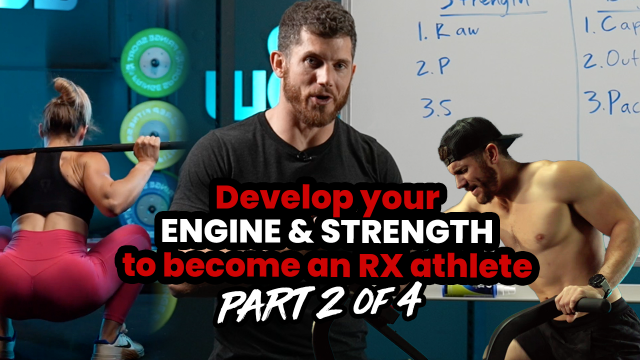Welcome back to the second installment of our blog series on how to become an RX athlete and reach the Quarterfinals. In Part 1, we delved into the foundational elements of Fitness—skill, strength, and engine—using a venn diagram to assess strengths and weaknesses.
Today, we're zooming in on strength and engine, exploring essential components and actionable strategies for improvement.
>> If you missed the venn diagram, head back to part one to catch up.
How To Develop Your Engine
When it comes to engine, three key aspects demand attention: capacity, output, and pacing.
Capacity:
This refers to your ability to sustain the demands of a workout. For instance, if a routine calls for a 24-calorie row per minute, maintaining that intensity throughout is crucial.
Lacking capacity results in underperformance, highlighting the need for focused training in this area.Output:
High-energy output is vital in CrossFit-style workouts. Whether it's assault bike sprints or rowing, the ability to reach and maintain high RPMs and heart rates is essential for success.
Without it, athletes risk falling short in workouts demanding quick bursts of power.Pacing:
Mastering pacing is paramount to avoiding burnout. Properly pacing workouts ensures consistent performance, preventing early fatigue and optimizing overall results.
Learning to maintain a steady pace, particularly in longer workouts, is a skill worth honing.
To improve your engine performance, consider including accessory programming focused on longer intervals or time trials in your weekly training.
Activities like steady-state cardio and specific interval training can effectively build capacity, output, and pacing.
How To Improve Your Strength
Strength training encompasses raw strength, positioning, and skill.
Raw Strength:
This foundational component is straightforward—how strong are you.
Improving raw strength in exercises like deadlifts and bench presses not only boosts overall strength but also increases performance across various movements.Positioning:
Often overlooked, positioning or mobility plays a crucial role in strength development.
Being able to achieve proper positions, such as in overhead squats, is essential for efficiently translating raw strength into functional movement.Skill:
High-skill lifts like snatches and cleans require not only strength but also coordination and technique.
Mastering these movements involves dedicated practice and precision, contributing to overall strength development.
To improve your strength, focus on exercises that target raw strength, mobility, and skill. Implementing accessory programming that emphasizes these areas can lead to significant improvements in performance.
So, what’s next?
Building a solid foundation in both engine and strength is essential for any aspiring RX athlete.
By addressing capacity, output, pacing, raw strength, positioning, and skill, athletes can improve their overall performance and edge closer to their fitness goals.
Stay tuned for Part 3, where we'll dive into skills and how to master them effectively. We're here to support your journey to the next level of fitness.
See you for part 3!

